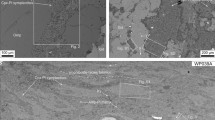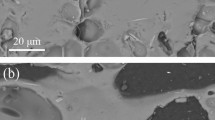Abstract
Cavities in two texturally and genetically distinct clasts of the Kaidun meteorite were found out to contain crystals of distinct morphology, but of a similar composition. Cavities in chondrite breccia #d3A contain thin (<4 μm) elongated (up to 25 μm long) crystals that grew perpendicular to the walls of the cavity. The walls of the cavities in partly fused clast #d(3–5)D are covered with clusters of acicular crystals. In both clasts, the crystals are covered by films of phyllosilicates and always have a composition approximated by the formula (Mg,Fe,Mn)5Al2O8·nH2O. No mineral phase of this composition has ever been found in nature. The genesis of the mineral phases in the cavities is thought to be related to the crystallization from a fluid of similar composition. The fluid was produced during the cooling of the melt that produced clast #d(3–5)D. The unusual composition of the crystals testifies that this fluid had an unusual composition. This can be explained by the unique nature of clast #d(3–5)D, for which there are good reasons to propose a Martian origin.
Similar content being viewed by others
References
A. V. Ivanov, N. N. Kononkova, and E. V. Guseva, “Hydrothermal Alterations of Schreibersite and Native Iron in the Meteorite Kaidun III (EH5),” Geokhimiya, No. 8, 1085–1093 (1992) [Geochem. Int. 30 (3), 11–19 (1993)].
A. V. Ivanov, G. Kurat, L. F. Migdisova, et al., “The Kaidun Meteorite: Pre-and Postaccretionary Aqueous Alterations of Metal in an Enstatite Chondrite Fragment,” Geokhimiya, No. 2, 131–136 (1998) [Geochem. Int. 36 (2), 101–106 (1998)].
A. V. Ivanov, M. E. Zolensky, F. Brandstaetter, et al., “A Phyllosilicate-Sulfide Vein in Kaidun,” Meteoritics 29, 477 (1994).
M. K. Weisberg, M. Prinz, M. E. Zolensky, and A. V. Ivanov, “Carbonates in the Kaidun Meteorite,” Meteoritics 29, 549–550 (1994).
A. V. Ivanov, M. E. Zolensky, and S. V. Yang, “The Kaidun Meteorite: Evidence for Aqueous Alteration and Precipitation,” Meteorit. Planet. Sci. 35(Suppl.), A82 (2000).
A. V. Ivanov, N. N. Kononkova, S. V. Yang, and M. E. Zolensky, “The Kaidun Meteorite: Clasts of Alkaline-rich Fractionated Materials,” Meteorit. Planet. Sci. 38, 725–737 (2003).
M. E. Zolensky, W. L. Dourcier, and J. L. Gooding, “Aqueous Alteration on the Hydrous Asteroids: Results of EQ3/6 Computer Simulations,” Icarus 78, 411–425 (1989).
V. V. Shcherbina, Principles of Geochemistry (Nedra, Moscow, 1972) [in Russian].
A. V. Ivanov, “Is the Kaidun Meteorite a Sample from Phobos?,” Astron. Vestn. 38(2), 113–125 (2004) [Sol. Sys. Res., 38 (2), 97–107 (2004)].
Author information
Authors and Affiliations
Corresponding author
Additional information
Original Russian Text © A.V. Ivanov, M.E. Zolensky, N.N. Kononkova, S.V. Yang, I.A. Stronganov, 2006, published in Geokhimiya, 2006, No. 3, pp. 284–292.
Rights and permissions
About this article
Cite this article
Ivanov, A.V., Zolensky, M.E., Kononkova, N.N. et al. Kaidun meteorite: Crystals of oxides in cavities. Geochem. Int. 44, 249–257 (2006). https://doi.org/10.1134/S0016702906030037
Received:
Issue Date:
DOI: https://doi.org/10.1134/S0016702906030037




